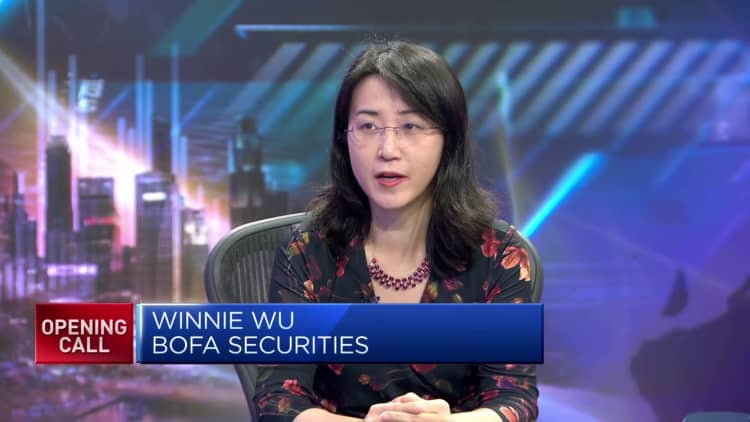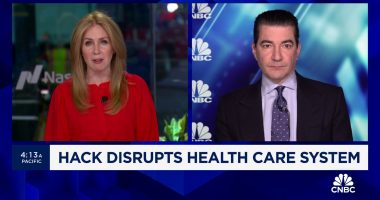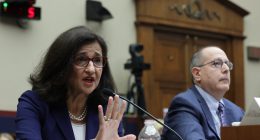BEIJING, CHINA – NOVEMBER 08: Pan Gongsheng, governor of the People’s Bank of China and head of the State Administration of Foreign Exchange, speaks during the Annual Conference of Financial Street Forum 2023 on November 8, 2023 in Beijing, China. (Photo by VCG/VCG via Getty Images)
Vcg | Visual China Group | Getty Images
BEIJING — Expectations for more support from China to boost its economy and stock markets are rising— especially after the central bank’s easing announcements on Wednesday.
Starting Feb. 5, the People’s Bank of China will allow banks to hold smaller cash reserves, central bank governor Pan Gongsheng said at a press conference, his first in the role.
Cutting the reserve requirement ratio (RRR) by 50 basis points is set to release 1 trillion yuan ($139.8 billion) in long-term capital, the central bank said.
“The latest [PBOC] announcements may be interpreted as the beginning of a policy pivot from previous reactive and piecemeal measures by investors, and they will continue to look for further signs and acts of policy support,” Tao Wang, head of Asia economics and chief China economist at UBS Investment Bank, said in a note Thursday.
Beijing has been reluctant to embark on massive stimulus, which would also widen the yield gap between China and the U.S. given the Federal Reserve’s tighter stance on monetary policy. The PBOC kept a benchmark lending rate unchanged again on Monday, holding pat on loan prime rates.
The magnitude of the central bank’s announcement Wednesday on the RRR cut exceeded Nomura’s forecast for a 25 basis point reduction, said the firm’s chief China economist, Ting Lu.
“We think this larger-than-expected RRR cut is a further sign that the PBoC and top policymakers have become increasingly concerned about the ongoing economic dip, which we have been flagging since mid-October last year, and the latest equity market performance,” he said in a note Thursday.
“More interestingly, the policy decision was revealed in a less-usual fashion, as the PBoC Governor made the announcement personally during a Q&A session at the press conference,” Lu said.

Pan on Wednesday told reporters the central bank and the National Financial Regulatory Administration would soon publish measures to encourage banks to lend to qualified developers. The document was released later that day.
“It is a significant step from the regulators to enhance credit support for developers,” UBS’ Wang said. “For developer financing to fundamentally and sustainably improve, property sales need to stop falling and start to recover, which could require more policy efforts to stabilize the property market.”
Real estate troubles are just one of several factors that have weighed on Chinese investor sentiment. The massive property industry has dragged down growth, and along with a slump in exports and lackluster consumption, kept the economy from rebounding from the pandemic as quickly as expected.
The mainland Chinese and Hong Kong stocks have steadily dropped to multi-year lows.
Stocks turned higher this week after a series of government announcements and media reports indicating forthcoming state support for growth and capital markets.
Such efforts to stabilize the stock market helps put a floor to stop the market from capitulating and falling further, Winnie Wu, Bank of America’s chief China equity strategist, said Thursday on CNBC’s “Street Signs Asia.”
But she pointed out a fundamental turnaround in the economy is needed for investors to return to Chinese stocks, which will take time.
A 2 trillion yuan boost?
The world’s second-largest economy grew by 5.2% in 2023, according to official numbers released last week. That’s a marked slowdown from double-digit growth in decades past.
Chinese Premier Li Qiang on Monday called for much stronger measures to boost market stability and confidence, according to an official readout.
On Tuesday, Bloomberg News, citing people familiar with the matter, said Chinese authorities are looking to use state-owned companies’ funds to stabilize the market — in a package of about 2 trillion yuan ($278 billion).
PBOC Governor Pan on Wednesday did not mention such a fund, although he took the initiative to speak about the capital markets, Citi’s Philip Yin and a team pointed out in a report. They said the 2 trillion yuan in capital would need to be deployed over weeks or months given current regulations, and would only amount to a fraction of current trading volume.
HAIAN, CHINA – JANUARY 24, 2024 – A staff member of the personal finance business area of a bank counts and arranges the RMB deposited by customers in the daily account in Haian city, Jiangsu province, China, Jan 24, 2024. (Photo credit should read CFOTO/Future Publishing via Getty Images)
Future Publishing | Future Publishing | Getty Images
“Most importantly, it seems not sufficient to create a real impact on the underlying challenges in the economy,” the Citi analysts said.
For many consumers and businesses in China, uncertainty about the future remains high in the wake of recent Chinese government crackdowns on internet technology companies, the gaming sector, after-school education businesses and real estate developers.
Tensions between the U.S. and China, centered on tech competition, have also weighed on sentiment.
Chinese authorities since last summer have made it a point to talk up support for the non-state, private sector.
“Ultimately what is going to get fundamentals back on track is meaningful improvement in confidence and sentiment – which is why recent measures have been designed to give confidence a boost,” said David Chao, global market strategist for Asia Pacific (ex-Japan) at Invesco.
“The road forward to economic normalization lies in the wallets of Chinese households and businesses and less so in China’s stimulus toolkit,” he told CNBC.
Looking for fiscal support
But markets have generally been waiting for more action. Chinese authorities in October already announced the issuance of 1 trillion yuan in government bonds, alongside a rare increase in the deficit.
“To address the macro challenges, it still calls for opening the monetary box even wider — and arguably with broader fiscal policy and easing deleveraging policy,” Citi’s analysts said.
Governor Pan’s comments about the narrowing difference between the U.S. and Chinese monetary policy are “clues for more monetary accommodation down the road especially with the Fed expected to ease later in the year,” the report said.
China is set to hold its annual parliamentary meeting in March, at which it could reveal a wider fiscal deficit and other policies for the year ahead.
The Economist Intelligence Unit on Thursday said in its China 2024 outlook that China’s leaders could aim for 5% growth in the year ahead, with the help of greater fiscal support.
The report pointed out that Chinese leaders called for a fresh round of fiscal reform during their annual Central Economic Working Conference in December. Those details could be released at the third plenary session of the Chinese Communist Party’s central committee, which is “likely to take place in early 2024,” EIU added.
— CNBC’s Clement Tan contributed to this report.
Read More: World News | Entertainment News | Celeb News
CNBC









